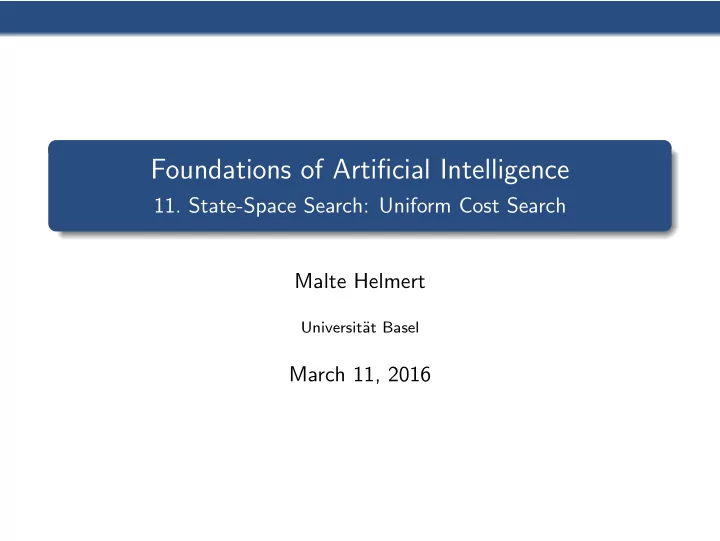

Foundations of Artificial Intelligence 11. State-Space Search: Uniform Cost Search Malte Helmert Universit¨ at Basel March 11, 2016
Introduction Algorithm Properties Summary State-Space Search: Overview Chapter overview: state-space search 5.–7. Foundations 8.–12. Basic Algorithms 8. Data Structures for Search Algorithms 9. Tree Search and Graph Search 10. Breadth-first Search 11. Uniform Cost Search 12. Depth-first Search and Iterative Deepening 13.–19. Heuristic Algorithms
Introduction Algorithm Properties Summary Introduction
Introduction Algorithm Properties Summary Uniform Cost Search breadth-first search optimal if all action costs equal otherwise no optimality guarantee � example: remedy: uniform cost search always expand a node with minimal path cost ( n .path cost a.k.a. g ( n )) implementation: priority queue (min-heap) for open list
Introduction Algorithm Properties Summary Uniform Cost Search breadth-first search optimal if all action costs equal otherwise no optimality guarantee � example: remedy: uniform cost search always expand a node with minimal path cost ( n .path cost a.k.a. g ( n )) implementation: priority queue (min-heap) for open list
Introduction Algorithm Properties Summary Algorithm
Introduction Algorithm Properties Summary Reminder: Generic Graph Search Algorithm reminder from Chapter 9: Generic Graph Search open := new OpenList open . insert(make root node()) closed := new ClosedList while not open . is empty(): n := open . pop() if closed . lookup( n . state) = none : closed . insert( n ) if is goal( n . state): return extract path( n ) for each � a , s ′ � ∈ succ( n . state): n ′ := make node( n , a , s ′ ) open . insert( n ′ ) return unsolvable
Introduction Algorithm Properties Summary Uniform Cost Search Uniform Cost Search open := new MinHeap ordered by g open . insert(make root node()) closed := new HashSet while not open . is empty(): n := open . pop min() if n . state / ∈ closed : closed . insert( n ) if is goal( n . state): return extract path( n ) for each � a , s ′ � ∈ succ( n . state): n ′ := make node( n , a , s ′ ) open . insert( n ′ ) return unsolvable
Introduction Algorithm Properties Summary Uniform Cost Search: Discussion Adapting generic graph search to uniform cost search: here, early goal tests/early updates of the closed list not a good idea. (Why not?) as in BFS-Graph, a set is sufficient for the closed list a tree search variant is possible, but rare: has the same disadvantages as BFS-Tree and in general not even semi-complete (Why not?) Remarks: identical to Dijkstra’s algorithm for shortest paths for both: variants with/without delayed duplicate elimination
Introduction Algorithm Properties Summary Uniform Cost Search: Improvements possible improvements: if action costs are small integers, bucket heaps often more efficient additional early duplicate tests for generated nodes can reduce memory requirements can be beneficial or detrimental for runtime must be careful to keep shorter path to duplicate state
Introduction Algorithm Properties Summary Properties
Introduction Algorithm Properties Summary Completeness and Optimality properties of uniform cost search: uniform cost search is complete (Why?) uniform cost search is optimal (Why?)
Introduction Algorithm Properties Summary Time and Space Complexity properties of uniform cost search: Time complexity depends on distribution of action costs (no simple and accurate bounds). Let ε := min a ∈ A cost ( a ) and consider the case ε > 0. Let c ∗ be the optimal solution cost. Let b be the branching factor and consider the case b ≥ 2. Then the time complexity is at most O ( b ⌊ c ∗ /ε ⌋ +1 ). (Why?) often a very weak upper bound space complexity = time complexity
Introduction Algorithm Properties Summary Summary
Introduction Algorithm Properties Summary Summary uniform cost search: expand nodes in order of ascending path costs usually as a graph search then corresponds to Dijkstra’s algorithm complete and optimal
Recommend
More recommend